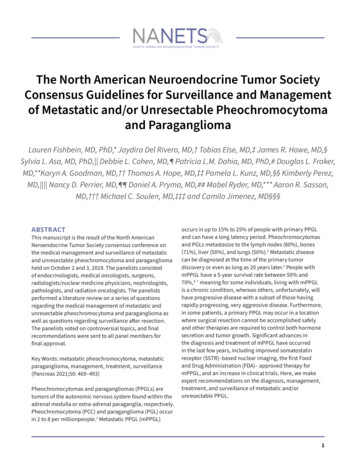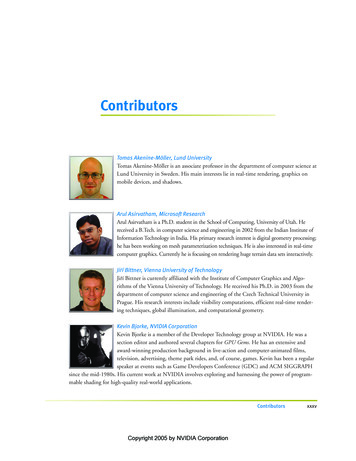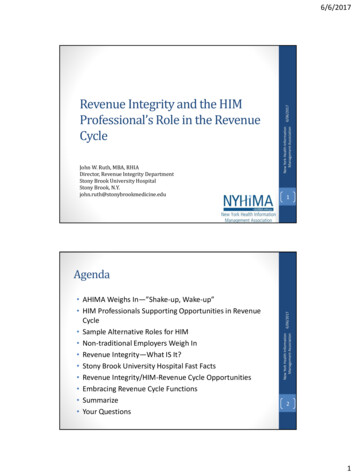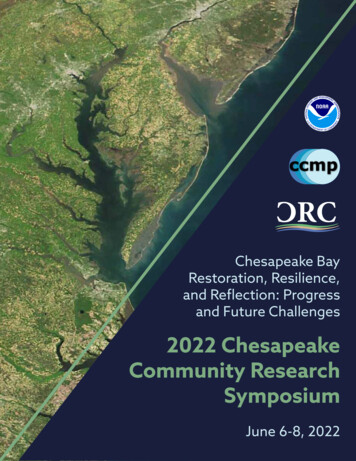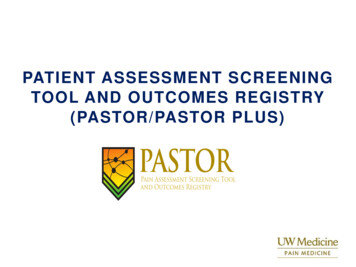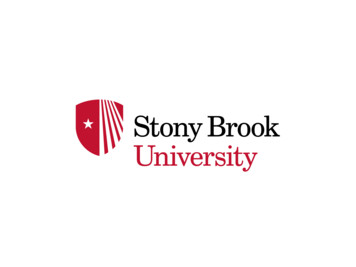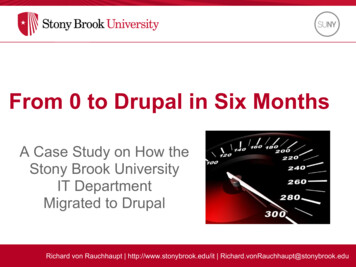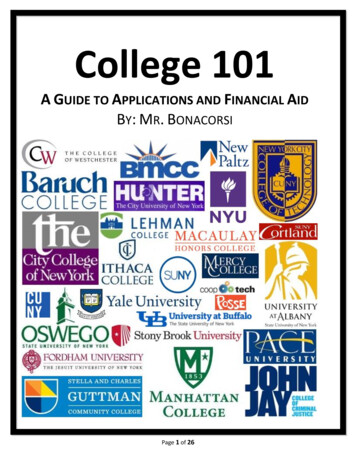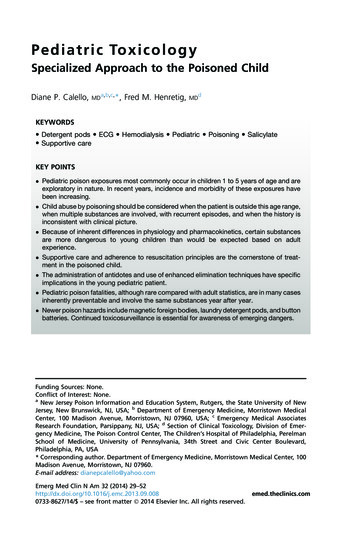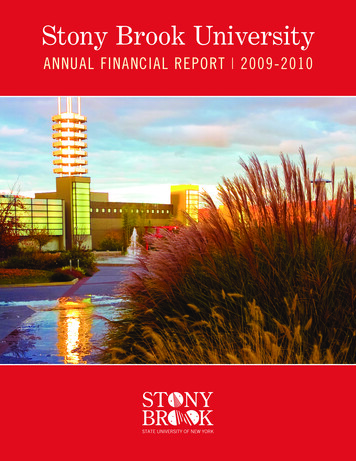
Transcription
Stony Brook UniversityANNUAL FINANCIAL REPORT 2009-2010
--TABLE OF CONTENTSThe Power of Stony Brook: Research, Education, and DiscoveryLetter to the PresidentFinancial Highlights2-456-9Stony Brook University Balance Sheet10Stony Brook University Statement of Revenues, Expenses, and Changes in Net Assets11Stony Brook University Statement of Cash Flows12-13Stony Brook Foundation Balance Sheet14Stony Brook Foundation Statement of Activities15Notes to Financial Statements16-28
The Power of Stony Brook:Research, Education, and DiscoveryAS ONE OF AMERICA’S MOST DYNAMIC RESEARCH UNIVERSITIES,STONY BROOK UNIVERSITY continues to strengthen its reputation asan innovative educator of the nation’s next leaders and a driving forcebehind the region’s economy.Ranked 25th among the best values in higher education by Kiplinger, Stony Brookhas consistently garnered recognition for its excellence in a number of academicdisciplines and for its integration of research with undergraduate education. We areone of only nine public institutions recognized for our undergraduate researchprogram by U.S.News & World Report, and eighth among public institutions placinggraduates in elite graduate programs in medicine, law, and business, according tothe Wall Street Journal.In addition to that recognition, the impressive surge in applications and enrollmentThe London Times HigherEducation ranksStony Brook University inthe top 1 percent of alluniversities worldwide. A member of the eliteAssociation of AmericanUniversities, Stony Brookis one of the 63 bestresearch institutions inNorth America. Stony Brook has 16 of thehighest ranked graduateprograms in the nation,according to U.S.News &World Report. NuclearPhysics, Geometry, andClinical Psychology areincluded in the top 10.has continued, along with notable increases in SAT scores and grade point averages.Growth in ResearchLocated in our rapidly growing Research and Development Park on campus,our Center of Excellence in Wireless and Information Technology (CEWIT) and ourAdvanced Energy Research and Technology Center are just two examples of theUniversity’s research partnerships with industry and with New York State.The 100,000-square-foot CEWIT building is home to 40 new research laboratories,7,000 square feet of incubator space, more than 70 faculty affiliates, and morethan 300 graduate students. CEWIT’s five divisions are Network Technologies,Software Systems, Communications and Devices, Systems and Infrastructure,and Medical Technology.The Advanced Energy Center is a partnership of academic institutions, research institutions, energy providers, and industrial corporations focusing on innovative energyresearch, education, and technology deployment. In the spring the Center announceda partnership with the New York State Department of Labor, The New York City LaborMarket Information Service at the CUNY Graduate Center, the State University of NewYork at Albany, and SUNY in the first comprehensive New York State research project2
to measure employer demand for “green jobs” against the capacity of educational andtraining resources to address this need.Stony Brook co-manages nearby Brookhaven National Laboratory (BNL) and is itssingle largest user. Established in 1947, BNL is the site of seven Nobel Prizewinning discoveries—five for research in physics. Each year more than 5,000visiting researchers from around the world join BNL’s 3,000 scientists, engineers,and support staff. More than 600 faculty, students, and staff from Stony Brookparticipate in groundbreaking research there.Stony Brook University reached a record 162 million in total sponsored programresearch expenditures at the end of the fiscal year in June. In addition, Stony Brookreceived 100 awards totaling 50 million under the American Recovery andReinvestment Act (ARRA) of 2009. Stony Brook accounts for more than 40 percent of allARRA funding SUNY-wide. All told, the entrepreneurial energy and economic strength ofthe University bring a combined benefit of 4.6 billion to the economy of Long Island.Growth in EducationThe Simons Center for Geometry and Physics has opened. Developed through funding from James Simons, former chair of Stony Brook’s Department of Mathematics,and his wife Marilyn, who holds a Ph.D. in economics from the University and ispresident of the Simons Foundation, the purpose of the Center is to bring togethermathematicians, in particular geometers, and theoretical physicists to inform andlearn from one another, and to work on problems of common interest to transformeach discipline. John Morgan is the Center’s first director, and Michael Douglas,internationally renowned string theorist, is its first permanent member.Stony Brook’s Center for Biotechnology brought some of the world’s top biosciencecompanies together with entrepreneurs and researchers to discuss biomedical solutions of the future in a Life Sciences Summit that focused on the development andmarketing of the next generation of medicines. The Summit was the only event of itskind bringing together established industry, academic innovators, and emergingcompanies to promote collaboration. In conjunction with the Summit, our Center forBiomolecular Diagnostics and Therapeutics—one of only eight New York State-supported Strategically Targeted Academic Research Centers—opened its doors. TheStony Brook is ranked 25thamong the best valuesin public colleges,according to Kiplinger. Our College of Engineeringand Applied Sciencesoffers sevenABET-accredited programs,our School of Marine andAtmospheric Sciencesfeatures waterfrontlearning, and we have theonly undergraduate Schoolof Journalism in New Yorkat a public university. SB grads earn more:We’re No. 23 onPayscale.com’s listof public colleges withtop-earning graduates.facility is the new home of the Center for Biotechnology and the Department ofBiomedical Engineering.3
The Athletics program has continued to grow, putting Stony Brook on the map witha record six championships. In 2009-10, the Stony Brook Seawolves were NCAADivision I conference champions in women’s cross country, and men’s basketball,soccer, lacrosse, football, and baseball. Stony Brook is now the No. 1 college sportsdestination on Long Island, and the Seawolves are well on their way to establishingthemselves on a national level.The Next 50 Years: A Time of DiscoveryThe future looks bright for Stony Brook, already recognized as an exceptionalresearch institution of higher learning by the Association of American Universities.Moving forward in these challenging economic times requires us to be more diligentand aggressive in managing our funds than ever before—to spend smarter whilecreating a platform to reach new heights and set new standards of excellence.With the launch by President Samuel L. Stanley Jr., M.D., earlier this year of Project50 Forward—a bold initiative designed to enhance the fundamental teaching,research, and service mission of the University—we are building a platform to supStony Brook UniversityMedical Center providesSuffolk County’s only Level1 trauma center, kidneytransplant program, burncenter, blood and marrowstem cell transplant program, regional perinatalcenter, and multidisciplinary autism center.port Stony Brook’s future growth and strengthen our role in the economic renewalof New York State. This major initiative will enable faculty and students at every levelto pursue scholarship, groundbreaking research, and revolutionary discovery, andthe University will be positioned for excellence for years to come.At the core of Project 50 Forward are three goals: operational excellence, academicgreatness, and building for the future. By working together to increase efficiency, streamline operations, develop new revenue streams, and return to our core missionSeawolves men’slacrosse put Stony Brookon the map in a big waywhen it made the NCAAquarterfinals in 2010.of teaching and research, Stony Brook will be propelled into the ranks of the top 20 Our PediatricMultiple Sclerosis Centerwas the first of its kindin the nation.4public research universities in the nation.
LETTER TO THE PRESIDENTJanuary 18, 2011President Samuel L. Stanley Jr., M.D.State University of New York at Stony BrookAdministration Building, Room 310Stony Brook, NY 11794-1701Dear Dr. Stanley:The accompanying financial statements prepared from the accounting records of Stony Brook University (hereafterreferred to as the University) set forth the financial condition of the University at June 30, 2010, including theresults of its operations for the fiscal year. Notes to the financial statements should be considered an integral partof the statements and the report as a whole. Prior-year data is provided to allow comparisons with the previousreporting period.Stony Brook University’s financial statements are consolidated in the annual financial report of the State University ofNew York (hereafter referred to as SUNY) as a component unit. Effective June 30, 2007, the University adopted afinancial statement format consistent with SUNY’s audited financial statements to comply with GASB and FASBpronouncements. The accompanying financial statements, to the extent possible, fairly represent the University’scomponent information as provided by SUNY.The financial information included in this report incorporates the major operations of the University, including theseparate entities of the State University of New York, the Research Foundation of the State University of New York,and the Faculty Student Association. The financial statements of the Stony Brook Foundation, a separate 501(c)(3)corporation, are presented on pages 14 and 15. The financial operations of the Clinical Practice Management Planare not included in this report. The annual report has been prepared in accordance with accounting principlesrecommended by the American Institute of Certified Public Accountants and the National Association of College andUniversity Business Officers to the degree practical.Sincerely,Karol Kain GrayVice President for Finance and Administration5
FINANCIAL HIGHLIGHTSStony Brook University at a GlanceStony Brook University, one of 64 campuses that constitute the State University of New York, was establishedin 1957 as a college for the preparation of secondary school teachers of mathematics and science. Since itsfounding, the University has grown tremendously and is now recognized as one of the nation’simportant centers of learning and scholarship.Stony Brook University has received high rankings both nationally and internationally as cited by the followingpublication and institutions: The London Times Higher Education World University Rankings, Shanghai HigherEducation Institute, U.S.News & World Report and the Wall Street Journal. With our growth in education,research, medicine, technology, and impact on the community, it’s easy to see why the New York Times callsStony Brook one of the nation’s most dramatic rising stars.The University offers more than 150 majors and minors, 91 master’s degree programs, 45 doctoral programs,and 38 graduate certificate programs. The University also offers more than 30 combined bachelor’s andmaster’s degree programs. Professional degrees are offered in medicine, dental medicine, nursing practice, andphysical therapy.Fiscal 2010 Revenues 1.86 BillionResearch AwardsFiscal 2010 Expenditures 1.92 BillionFoundation RevenueTotal RevenueResearch Awards(in millions)Tuition and Fees 133.6 219.73 Million 32.82 Million(in millions)Federal 144.9State Appropriations462.3Philanthropic (Private)16.3Federal Grants151.8State and Local34.4Other24.1State, Local and Private Grants, and Other87.6Auxiliary on(in millions)Gifts and Gifts-in-KindOther6 21.611.2Net Assets-Endowment101.1Total Net Assets190.1Endowment Rate of Return7.9%
FINANCIAL HIGHLIGHTSEconomic ImpactStony Brook University is vital to the economy of the Long Island region. It is Long Island’s largest single-siteemployer, providing jobs to nearly 14,000 employees. As Long Island’s only public research university, theUniversity produces the educated workforce that drives the area’s high-tech economy. In fact, according to areport released by the Center for Regional Policy Studies, the University’s impact on the Long Island economyamounts to 4.7 billion in increased output, or gross regional domestic product, and nearly 60,000 jobs.Tuition and FeesEmploymentTotal Employees (full and part time)13,654(Fall 2010)Undergraduate and GraduateAcademic3,295Undergraduate NYS 7,552Non-Academic4,697Undergraduate Nonresident15,9625,662Graduate NYS10,335Graduate Nonresident15,480Graduate MBA NYS11,345Graduate MBA Nonresident17,105HospitalAverage Monthly PayrollStudent Enrollment 70.5 million(Fall 2010)Total Student Enrollment24,594UndergraduateTotal Undergraduate Students16,424HSC ProfessionalWest Campus15,305Medical NYSHSC Campus1,119High School GPA PercentAverage SAT Score911225Graduate and Advanced DegreesTotal Graduate Students8,170West Campus5,857HSC Campus2,313 27,344Medical Nonresident51,264Dental NYS32,073Dental Nonresident57,953Physical Therapy NYS17,065Physical Therapy Nonresident28,595Other Facts The New York State Energy Research and Development Authority (NYSERDA) has awarded a 1.5 million grant toStony Brook to establish a Clean Energy Business Incubator Program (CEBIP) on the campus. The American Association for the Advancement of Science named three Stony Brook University faculty 2009 fellows. The Emerson String Quartet, Stony Brook’s resident ensemble, won its ninth GRAMMY award for Best ChamberMusic Performance for its May 2009 recording of “Intimate Letters.” Thirty-four high school students who worked with Stony Brook University faculty were selected as semifinalists in theIntel Science Talent Search, the prestigious nationwide research competition. The Howard Hughes Medical Institute has awarded Stony Brook University a four-year, 1.5 million grant to enhancescience education. In June 2010, Stony Brook University Medical Center (SBUMC) broke ground on its new Comprehensive EmergencyPsychiatric Program (CPEP) Annex, an enhanced psychiatric care environment, which is expected to be completedin Fall 2011.7
FINANCIAL HIGHLIGHTSRevenue ResultsTotal revenues were 1,860,703,339 and 1,745,657,523 for the 2010 and 2009 fiscal years, respectively. The 115 million revenue increase in 2010 is the result of the following: Hospital revenues were 48 million greater than 2009, the result of new patient services and increasedhospital occupancy. Nonoperating revenues were 40 million greater than 2009 primarily due to increases in federal andstate student financial aid programs and in net realized and unrealized investment gains. Federal, state, local, and private grants and contracts, and other revenues exceeded 2009 by 31 million. Tuition and fees and auxiliary enterprise revenues exceeded 2009 by 22 million. State appropriations for the direct support of operations and indirect costs (i.e., debt service, fringe benefits)decreased 26 million from 2009 appropriations.The accompanying graph depicts results as a percentage of current year revenues.2010 Revenues4%5%5%7%46%8%25%Hospital and clinicsState appropriationsFederal grants and contractsTuition and feesAuxiliary enterprisesState, local, and private grants and contracts, and otherNonoperating8
FINANCIAL HIGHLIGHTSExpenditure ResultsExpenditures reported for 2010 were 1,918,743,736, a 95 million increase from 2009 expenditures of 1,823,787,442 as a result of: Hospital and clinic expenditures exceeded 2009 expenses by 35 million largely due to increased litigationcosts, personal services costs, and staff benefits. Support services, which include academic support, student services, institutional support, and operationsand maintenance, were 18 million greater than 2009 expenditures. Research expenditures were 11 million greater than 2009 expenses. Depreciation expenses associated with capital assets increased by 10 million. Public service and other expenditures increased 9 million. Instruction and education expenditures were 6 million in excess of 2009. Scholarship and fellowships expenditures increased by 6 million.The accompanying graph depicts results as a percentage of current year expenditures.2010 Expenditures1% 1% 3% 4%5%6%15%49%16%Hospital and clinicsSupport servicesInstructionResearchAuxiliary enterprisesDepreciation expenseNonoperatingScholarships and fellowshipsPublic service9
ANNUAL FINANCIAL REPORTSTONY BROOK UNIVERSITYBALANCE SHEETFOR THE YEARS ENDING JUNE 3020102009ASSETSCurrent AssetsCash and cash equivalentsShort-term investmentsAccounts, notes, and loans receivable, netInterest receivableAppropriations receivableGrants receivableInventoriesOther assetsTotal current assetsNoncurrent AssetsRestricted cash and cash equivalentsDeposits with trusteesAccounts, notes, and loans receivable, netAppropriations receivableDeferred financing costsLong-term investmentsCapital assets, netTotal noncurrent assetsTOTAL ASSETSLIABILITIES AND NET ASSETSCurrent LiabilitiesAccounts payable and accrued liabilitiesInterest payableStudent depositsDeposits held in custody for othersDeferred revenueLong-term liabilities-current portionOther liabilitiesTotal current liabilitiesNoncurrent LiabilitiesLong-term liabilitiesRefundable government loan fundsOther liabilitiesTotal noncurrent liabilitiesTotal liabilitiesNET ASSETSInvested in capital assets, net of related debtLoans - restricted and expendableUnrestrictedTotal net assetsTOTAL LIABILITIES AND NET ASSETSSee accompanying notes to financial statements.10 ,476,7087,539,3199,522,867 54,174437,591,199768,676(28,765,304)409,594,571 2,121,149,993 1,969,877,523
ANNUAL FINANCIAL REPORTSTONY BROOK UNIVERSITYSTATEMENT OF REVENUES, EXPENSES, AND CHANGES IN NET ASSETSFOR THE YEARS ENDING JUNE 3020102009OPERATING REVENUESTuition and feesLess: scholarship allowancesNet tuition and feesFederal grants and contractsState grants and contractsLocal grants and contractsPrivate grants and contractsUniversity hospitals and clinicsSales and services of auxiliary enterprises:Residence halls, netFood service, netOther auxiliary, netOther operatingTotal operating revenues 5,0821,678,57441,440,478849,947,319 15,78525,302,59720,497,1241,226,626,956OPERATING EXPENSESInstructionResearchPublic serviceAcademic supportStudent servicesInstitutional supportOperation and maintenance of plantScholarships and fellowshipsHospitals and clinicsResidence hallsFood serviceOther auxiliaryDepreciation and amortization expenseOther operatingTotal operating expendituresOperating 5,039,049(78,129,919)487,724,490 351,554,174 409,594,571NONOPERATING REVENUES (EXPENSES)State appropriationsFederal and State student financial aidInvestment income, net of investment feesNet realized and unrealized gains (losses)GiftsInterest expense on capital related debtLoss on disposal of plant assetsOther nonoperating revenues (expenses), netNet nonoperating revenuesIncome (loss) before other revenues and gainsCapital appropriationsCapital gifts and grantsIncrease (decrease) in net assetsNet assets at the beginning of yearNET ASSETS AT THE END OF YEARSee accompanying notes to financial statements.11
ANNUAL FINANCIAL REPORTSTONY BROOK UNIVERSITYSTATEMENT OF CASH FLOWSFOR THE YEARS ENDING JUNE 302010CASH FLOWS FROM OPERATING ACTIVITIESTuition and feesFederal grants and contractsState and local grants and contractsPrivate grants and contractsUniversity hospitals and clinicsPersonal service paymentsOther than personal service paymentsPayments for fringe benefitsPayments for scholarships and fellowshipsLoans issued to studentsCollection of loans to studentsResidence halls, netFood service, netOther auxiliary, netOther operatingNet cash used by operating activitiesCASH FLOWS FROM NONCAPITAL FINANCING ACTIVITIESState appropriations:OperationsDebt serviceFederal and State student financial aid grantsPrivate gifts and grantsRepayment of short-term loansOther paymentsNet cash flows provided by noncapital financing activities ,72019,525,751(126,280,789) 6,331,981CASH FLOWS FROM CAPITAL AND RELATED FINANCING ACTIVITIESProceeds from capital debt182,076,201Capital appropriations135,418Capital grants and gifts received1,490,439Purchases of capital assets(30,213,033)Payments to contractors(180,887,162)Principal paid on capital debt and leases(52,154,628)Interest paid on capital debt and leases(34,115,048)Other receipts (payments)(923,696)Net cash used by capital and related financing activities(114,591,509)See accompanying notes to financial ,015)
ANNUAL FINANCIAL REPORTSTONY BROOK UNIVERSITYSTATEMENT OF CASH FLOWSFOR THE YEARS ENDING JUNE 302010CASH FLOWS FROM INVESTING ACTIVITIESProceeds from sales and maturities of investmentsInterest, dividends, and realized gains on investmentsPurchases of investmentsNet cash provided (used) by investing 2,057,5276,955,127(3,075,965)5,936,689Net change in cashCash - beginning of yearCash - end of 0,228,905223,905,549END OF YEAR CASH COMPRISED OFCash and cash equivalentsRestricted cash and cash 52Total cash - end of 380,631245,148,943239,642,454RECONCILIATION OF NET OPERATING LOSS TONET CASH USED BY OPERATING ACTIVITIESOperating lossADJUSTMENTS TO OPERATING LOSSDepreciation and amortization expenseFringe benefits and litigation costs provided by StateCHANGE IN ASSETS AND LIABILITIESReceivables, netInventoriesOther assetsAccounts payable, accrued expenses, and other liabilitiesDeferred revenueStudent depositsDeposits held for othersNet cash used by operating activitiesSUPPLEMENTAL DISCLOSURES FORNONCASH TRANSACTIONSNew capital leases/debt agreementsFringe benefits and litigation costs provided by the StateNoncash gifts1,490,439See accompanying notes to financial statements.13
ANNUAL FINANCIAL REPORTSTONY BROOK FOUNDATIONBALANCE SHEET2010ASSETSCurrent AssetsCash and cash equivalentsAccounts and notes receivable, netPledges receivable, netInvestmentsOther assetsCapital assets, netTotal assetsFOR THE YEARS ENDING JUNE 302009 ,994229,959,949 Temporarily restrictedScholarships and fellowshipsCampus programsResearchGeneral operations and ,75119,725,2578,973,30874,048,194Permanently restrictedScholarships and fellowshipsCampus programsResearchGeneral operations and otherTotal net 85,654 229,959,949 235,537,953LIABILITIES AND NET ASSETSLiabilitiesAccounts payable and accrued expensesCurrent portion of long-term debtDeposits held for othersLong-term debtOther liabilitiesTotal liabilitiesNET ASSETSUnrestrictedBoard designated for:Campus programsUndesignatedTOTAL LIABILITIES AND NET ASSETSSee accompanying notes to financial statements.14
ANNUAL FINANCIAL REPORTSTONY BROOK FOUNDATIONSTATEMENT OF ACTIVITIESREVENUESContributions, gifts, and grantsFOR THE YEARS ENDING JUNE NTLYRESTRICTEDTOTALTOTAL 1,013,940 16,933,393 1,395,538Investment income, netNet realized and unrealized gains 209,354)1,109,045Program income and special eventsOther revenues(116,562)(43,651)Endowment earnings transferred(1,145,746)1,145,746Net assets released from 1,501)Total revenues 79,425,8666,669,154Rental incomeSales and services 18,51036,718,51015,791,730Payments to State University:Scholarships and fellowships2,929,6052,929,6052,463,171Other expensesEXPENSESProgram expenses1,569,7751,569,775816,621Depreciation and amortization expense602,167602,167667,288Interest expense on capital-related 15Management and generalFundraisingTotal 203,485,654163,403,230 190,148,114 203,485,654Increase (decrease) in net assets3,578,423(18,311,501)Net assets at the beginning of 0(1,779,730) 9,333,125 101,091,689 79,723,300Transfer of net assetsNET ASSETS AT THE END OF YEARSee accompanying notes to financial statements.15
ANNUAL FINANCIAL REPORTNOTES TO FINANCIAL STATEMENTS1. Summary of Significant Accounting Policies andBasis of PresentationFinancial PresentationIn June 2007, Stony Brook University (the University) adopted a financial statement format consistent withthe State University of New York’s (SUNY) audited financial statements. The University assumed this positionin order to conform to GASB and FASB pronouncements. The University has relied on information provided bySUNY for the allocation of various net asset values not easily identified by the University.Reporting EntityFor financial reporting purposes, the University is comprised of sectors which include the university centersof the main campus, Manhattan, and Southampton, health science centers (including hospitals), collegesand schools, central services and other affiliated entities determined to be includable in the University’sfinancial reporting entity.Inclusion in the entity is based primarily on the notion of financial accountability. Governmental AccountingStandards Board (GASB) Statement No. 14, as amended by GASB Statement No. 39, defines financialaccountability in terms of a primary government (University) that is financially accountable for theorganizations that make up its legal entity. It is also financially accountable for legally separate organizationsif its officers appoint a voting majority of an organization’s governing body and either it is able to impose itswill on that organization or there is a potential for the organization to provide specific financial benefits to,or to impose specific financial burdens on, the primary government. A primary government may also befinancially accountable for governmental organizations that are fiscally dependent on it.Inclusion in the reporting entity is also required for legally separate, tax-exempt, affiliated organizations that(a) receive or hold economic resources that are significant to, and entirely or almost entirely for the directbenefit of, the primary government, its component units, or its constituents and (b) the primary government,or its component units, is entitled to, or can otherwise access, a majority of the economic resources receivedor held by the separate organization. As a result, the Stony Brook Foundation Inc. (the Foundation) isincluded in the University’s reporting entity. The Foundation is presented as an aggregate component uniton financial statement pages 14 and 15 in the University’s financial statements in accordance with displayrequirements prescribed by the Financial Accounting Standards Board (FASB). The financial activity wasderived from financial statements of the Foundation for the years ended June 30, 2010 and 2009.The Research Foundation of State University of New York at Stony Brook (Research Foundation) is aseparate not-for-profit educational corporation that operates as the fiscal administrat
Market Information Service at the CUNY Graduate Center, the State University of New York at Albany, and SUNY in the first comprehensive New York State research project 2. Stony Brook is ranked 25th among the best values . The University offers more than 150 majors and minors, 9
